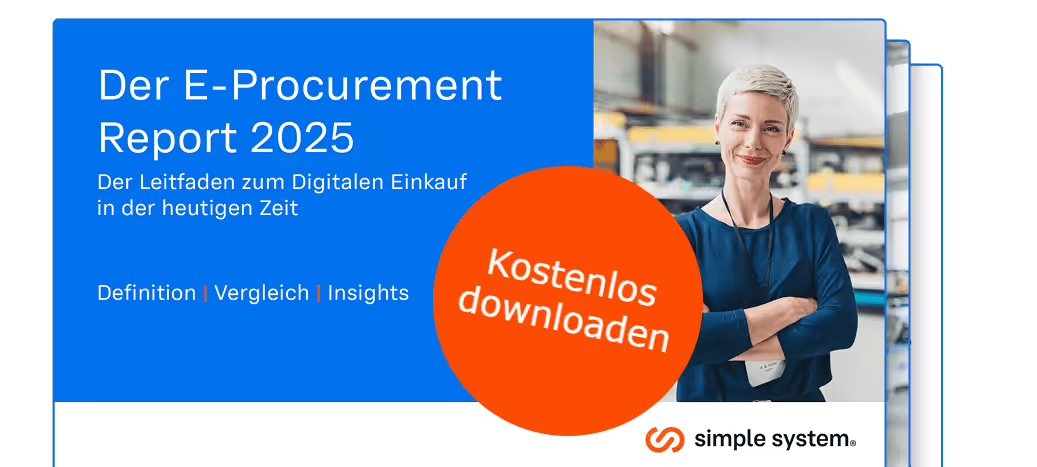Key figures (KPIs) optimize procurement by measuring costs, efficiency, and supplier performance. Key KPIs include TCO, ROI, on-time delivery, and level of automation. Regular review and digital tools improve purchasing strategy and competitiveness.
Procurement indicators — The most important key figures and KPIs in purchasing
Key figures (KPIs) play a vital role in monitoring efficiency and profitability within the procurement process. They provide valuable insights and form the basis for sound decision-making. By carefully selecting the right KPIs, companies can identify bottlenecks early, reduce spending, and improve collaboration with suppliers. But which key figures exist, and which carry the most weight in the procurement process?
At a glance
- Strategic orientation – KPIs should be closely aligned with corporate goals.
- Comprehensive coverage – Indicators should ideally reflect different areas of the business, such as finance, customers, and processes.
- Regular review – KPIs must be reviewed and adjusted regularly to reflect changing market conditions.
- Relevant metrics – Total procurement costs, delivery punctuality, and order processing times are among the most important indicators.
- Digitization – Modern solutions, such as e-procurement systems, increase purchasing efficiency through automation and transparency.
Definition - What is a KPI in Procurement?
A KPI (Key Performance Indicator) is a measurable size in purchasing and sourcing, that is regularly tracked to show developments over both short and long periods of time. It serves as a basis for managing the procurement organization.
Why are key figures crucial in procurement?
They are an essential tool for strategic purchasing. With the help of key figures processes can be monitored and optimized. KPIs provide valuable insights and support well-founded decisions. It is important to distinguish between key figures and key performance indicators: key figures are general measurements, whereas KPIs are specific performance indicators directly tied to strategic corporate objectives.
The most important key figures in procurement
To effectively assess and improve the performance and efficiency of shopping Tit is crucial to select relevant KPIs. These metrics deliver valuable insights into different aspects of the procurement process and enable targeted optimization. The following have been identified as particularly effective in procurement controlling:
Monetary figures

Monetary indicators are critical for evaluating financial performance in the procurement process. The most important monetary figures include:
- Total cost of ownership (TCO) – This indicator accounts for all direct and indirect purchasing costs of a good or service.
- Free cash flow – Shows the amount of funds an organization has available after deducting all expenses and investments.
- Return on investment (ROI) – Measures the profitability of investments in procurement by comparing the capital invested to the resulting sales.
- Potential savings through negotiations – Highlights cost reductions achieved through effective negotiation strategies.
- Cost per order – Captures the average effort and total process costs required to process a single order.
Supplier management key figures

Supplier management indicators are essential for evaluating and optimizing procurement processes in relation to suppliers. The most important KPIs include:
- On-time delivery rate – Measures the punctuality of deliveries as a percentage and reflects supplier reliability. A high on-time delivery rate ensures smooth production processes and results in satisfied customers.
- Supplier evaluation and performance – Assesses suppliers based on factors such as price, quality, willingness to cooperate, and adherence to deadlines.
- Average delivery time (lead time) – Calculated as the delivery date minus the order date, indicating the time between order placement and delivery to the customer.
- Complaint rate – Indicates product quality by comparing the number of complaints to the total number of deliveries.
Efficiency indicators in the purchasing process

Efficiency indicators in the procurement process measure the performance and profitability of individual purchasing activities. They help companies identify optimization potential and improve both efficiency and profitability. Key efficiency KPIs include:
- Order processing times – Measures the time between order receipt and completion, including pre-processing, processing, and shipping.
- Level of automation in purchasing – Indicates the ratio of automated tasks to the total number of tasks in the procurement process. The higher the level of automation, the better.
- Maverick buying (unauthorized orders) – Tracks the number of purchases made outside established procurement processes. Such unauthorized orders often lead to inefficiency and uncontrolled spending.
Selection of relevant KPIs to optimize procurement

The significance of KPIs depends on individual objectives and the specific circumstances of the company. A balanced mix of key performance indicators from various areas ensures a holistic analysis of procurement performance. When selecting KPIs, procurement and logistics departments should follow their own timelines, involve all relevant business areas, and differentiate between strategic and operational goals.
Regular checks and adjustments of KPIs are essential to ensure that they remain relevant and meaningful. The following recommendations can help in selecting suitable indicators for your needs:
1. Alignment with corporate strategy
KPIs should always be closely linked to the company’s strategy. They act as a guide, steering the organization toward its long-term goals and providing regular feedback. When selecting KPIs, it is important to choose those that best represent the key aspects of the business strategy. The right selection ensures that all business activities align with the company’s overall objectives.
2. Covering all relevant business areas
To gain a holistic view of performance, KPIs should cover all important business areas, including finance, customer relationships, internal processes, and employee development. Broad coverage ensures that companies monitor not only financial metrics but also customer satisfaction, process efficiency, and workforce productivity. This comprehensive analysis reveals connections between departments and supports data-driven decision-making, ultimately enhancing the company’s overall health.
3. Differentiating between strategic and operational goals
In short, strategic goals set the company’s long-term direction, while operational goals operational goals focus on day-to-day implementation. The two differ in time horizon and scope.
4. Regular review and adjustment of KPIs
KPIs should evolve alongside the company and its environment. Regular evaluation ensures they remain relevant and meaningful. Changing markets, emerging technologies, and shifting strategies require procurement metrics to be flexible. Annual or semi-annual reviews help keep KPIs up to date, enabling agility and quick responses to market changes.
Tools and software for measuring procurement indicators
Modern tools and software are vital for measuring and analysing procurement KPIs. ERP systems and e-procurement platforms are particularly important. ERP solutions such as SAP offer comprehensive capabilities for buyers — from planning to automating procurement processes — enabling centralized data management and greater transparency. E-procurement platforms complement ERP systems by optimizing operational purchasing and providing intuitive user interfaces. They simplify catalogue management, streamline ordering, and enhance overall efficiency.
One such e-procurement solution is simple system, which integrates seamlessly with existing ERP systems and significantly reduces manual effort. With access to 850 suppliers and 80 million items, it also offers advanced analytics and clear procurement dashboards. These tools enable companies to visualize purchasing behaviour, assess supplier performance, and identify optimization potential.
Synopsis
By continuously monitoring KPIs, companies can optimize their procurement processes and maintain market presence. Regular tracking helps detect trends early, reveal weaknesses, and support well-founded decisions. It also enables rapid responses to market changes and swift implementation of improvement measures. Any deviations from plan are quickly identified, allowing immediate corrective actions to ensure goals are achieved.
KPIs in materials management, form the foundation of a successful procurement strategy. Modern tools and e-procurement solutions like simple system enhance procurement organizations by automating data collection and delivering meaningful dashboards. These digital solutions allow real-time monitoring and data-driven decision-making — two critical factors for gaining a competitive edge.
Frequently asked questions
Frequently Asked Questions
How often should KPIs be reviewed and adjusted?
A review of the most important KPIs every six to twelve months is recommended to respond promptly to market changes.
What are common mistakes when choosing KPIs in procurement?
Focusing on too many KPIs at once and neglecting qualitative aspects.
Why is Total Cost of Ownership (TCO) an important KPI?
TCO considers all costs associated with a product or service — not just the initial purchase — enabling well-founded procurement decisions.
How does the level of automation in procurement affect efficiency?
A high level of automation shortens processing times, reduces errors, and strengthens strategic orientation — making it a valuable advantage for companies facing competition.

Einkaufen & sparen
Erfahren Sie, wie es geht, in unserem kostenlosen E-Procurement-Report. Jetzt kostenlos und unverbindlich herunterladen.
Jetzt lesen








